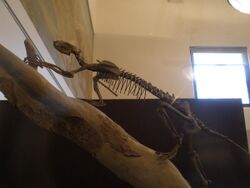Biology:Miacidae
| Miacidae | |
|---|---|

| |
| skull of Miacis parvivorus | |

| |
| skeleton of Vulpavus ovatus | |
| Scientific classification | |
| Domain: | Eukaryota |
| Kingdom: | Animalia |
| Phylum: | Chordata |
| Class: | Mammalia |
| Clade: | Carnivoraformes |
| Family: | †Miacidae Cope, 1880[1] |
| Type genus | |
| †Miacis Cope, 1872
| |
| Genera | |
|
[see classification]
| |
| Synonyms | |
|
list of synonyms:
| |
Miacidae ("small points") is a former paraphyletic family of extinct primitive placental mammals that lived in North America, Europe and Asia during the Paleocene and Eocene epochs, about 65-33,9 million years ago.[9][10][11][12] These mammals were basal to order Carnivora, the crown-group within the Carnivoraformes.
Miacids are thought to have evolved into the modern carnivorous mammals of the order Carnivora. They were small carnivores, superficially marten-like or civet-like with long, lithe bodies and long tails. Some species were arboreal, while others lived on the ground.[13]
They probably fed on invertebrates, lizards, birds, and smaller mammals like shrews and opossums. Their teeth and skulls show that the miacids were less developed than modern carnivorans. They had carnivoran-type carnassials, but lacked fully ossified auditory bullae (rounded protrusions).
Classification
History of classification
Miacidae as traditionally conceived is not a monophyletic group; it is a paraphyletic array of stem taxa. Traditionally, Miacidae and Viverravidae had been classified in a superfamily, Miacoidea. Today, Carnivora and Miacoidea are grouped together in the crown-clade Carnivoramorpha, and the Miacoidea are regarded as basal carnivoramorphs. Some species of the genus Miacis are closely related to the order Carnivora, but only the species Miacis australis and Miacis cognitus are a true carnivorans, as they are classified in the family Amphicyonidae within Caniformia.
The divergence of carnivorans from miacids is now inferred to have occurred in the middle-Eocene (ca. 42 million years ago).[14] Traditionally, the Viverravidae (viverravids) had been thought to be the earliest carnivorans, with fossil records first appearing in the Paleocene of North America about 66 million years ago, but recent cranial morphology evidence now places them outside the order Carnivora.[15] Later authorities disagreed, and propose that the viverravids arose in North America 66-60 million years ago, spread to Asia then later to Europe, and were the first carnivorans and possessed the first true pair of carnassial teeth.[16]:p8
It has been proposed that miacids arose in North America and Europe 60-50 million years ago then later spread to Asia.[17] Like the earlier viverravids, they possessed a true pair of carnassial teeth and therefore are related to order Carnivora.[18] They also possessed a full set of cheek teeth, were weasel to small fox sized, and lived in forests. All modern carnivorans arose from them.[16]:p9
Taxonomy
- Family: †Miacidae (Cope, 1880)
- Genus: †Chailicyon (Chow, 1975)
- Genus: †Eogale (Beard & Dawson, 2009)
- Genus: †Gracilocyon (Smith & Smith, 2010)
- Genus: †Harpalodon (Marsh, 1872)
- Genus: †Lycarion (Matthew, 1909)
- Genus: †Messelogale (Springhorn, 2000)
- Genus: †Miacis (Cope, 1872)
- Genus: †Miocyon (Matthew, 1909)
- Genus: †Neovulpavus (Wortman, 1901)
- Genus: †Oodectes (Wortman, 1901)
- Genus: †Palaearctonyx (Matthew, 1909)
- Genus: †Paramiacis (Mathis, 1985)
- Genus: †Paroodectes (Springhorn, 1980)
- Genus: †Procynodictis (Wortman & Matthew, 1899)
- Genus: †Prodaphaenus (Wortman & Matthew, 1899)
- Genus: †Quercygale (Kretzoi, 1945)
- Genus: †Simamphicyon (Viret, 1942)
- Genus: †Tapocyon (Stock, 1934)
- Genus: †Uintacyon (Leidy, 1873)
- Genus: †Vassacyon (Matthew, 1909)
- Genus: †Vulpavus (Marsh, 1871)
- Genus: †Xinyuictis (Zheng, 1975)
- Genus: †Zodiocyon (Tong & Wang, 2006)
References
- ↑ E. D. Cope (1880.) "On the genera of the Creodonta." Proceedings of the American Philosophical Society 19:76-82
- ↑ W. D. Matthew (1909) "The Carnivora and Insectivora of the Bridger Basin, middle Eocene." Memoirs of the American Museum of Natural History 9:289-567
- ↑ Haeckel, Ernst (1895) (in de). Systematische Phylogenie: Wirbelthiere. T.3. Berlin: G. Reimer. https://archive.org/details/systematischephy03haec/page/601.
- ↑ Trouessart, E. L. (1885) "Note sur le classification des Analgésiens et diagnoses d'espèces et de genres nouveaux." Bulletin de la Société d'études scientifiques d'Angers, 14, 46–89. [Publ. February, 1885. for year 1884.]
- ↑ Kalandadze, N. N. and S. A. Rautian (1992.) "Systema mlekopitayushchikh i istorygeskaya zoogeographei [The system of mammals and historical zoogeography]." Sbornik Trudov Zoologicheskogo Muzeya Moskovskogo Goschdarstvennoro Universiteta 29:44–152.
- ↑ Tielhard de Chardin, P. (1915) "Les carnassiers des phosphorites du Quercy" Annales de Paléontologie, 9, 101–192
- ↑ Miklos Kretzoi (1945) "Bemerkungen über das Raubtiersystem." Annales Historico-Naturales Musei Nationalis Hungarici, Budapest, vol. 38, pp. 59-83.
- ↑ O. P. Hay (1902.) "Bibliography and Catalogue of the Fossil Vertebrata of North America." Bulletin of the United States Geological Survey 179:1-868
- ↑ McKenna, Malcolm C.; Bell, Susan K. (1997). Classification of Mammals Above the Species Level. New York: Columbia University Press. ISBN 978-0-231-11012-9. https://books.google.com/books?id=OLYifwU8bqQC&pg=PP9. Retrieved 16 March 2015.
- ↑ J. J. Flynn (1998.) "Early Cenozoic Carnivora ("Miacoidea")." In C. M. Janis, K. M. Scott and L. L. Jacobs (eds.) "Evolution of Tertiary Mammals of North America. Volume 1: Terrestrial Carnivores, Ungulates, and Ungulatelike Mammals." Cambridge University Press, Cambridge. ISBN:9780521355193
- ↑ "Miacidae in the Paleobiology Database". Fossilworks. http://www.fossilworks.org/cgi-bin/bridge.pl?a=taxonInfo&taxon_no=40978.
- ↑ IRMNG (2018). Miacidae Cope, 1880 †. Accessed at: http://www.irmng.org/aphia.php?p=taxdetails&id=102911 on 2019-01-22
- ↑ Cost, Ian N. (2013-10-02). "Extinct Animal of the Week: Before Things Got Dire". https://dinooftheweek.blogspot.com/2013/10/before-things-got-dire.html.
- ↑ "Ancestors". http://redwolfspecies.weebly.com/ancestors.html.
- ↑ Polly, David, Gina D. Wesley-Hunt, Ronald E. Heinrich, Graham Davis and Peter Houde (2006). "Earliest Known Carnivoran Auditory Bulla and Support for a Recent Origin of Crown-Clade Carnivora (Eutheria, Mammalia)". Palaeontology 49 (5): 1019–1027. doi:10.1111/j.1475-4983.2006.00586.x. http://mypage.iu.edu/~pdpolly/Papers/Polly%20et%20al,%202006,%20Viverravus.pdf.
- ↑ 16.0 16.1 Wang, X.; Tedford, R. H. (2008). Dogs: Their Fossil Relatives and Evolutionary History. Columbia University Press. ISBN 978-0-231-13529-0. OCLC 822229250. https://books.google.com/books?id=degwyTaHLt8C&pg=PA9.
- ↑ "Miacis | extinct mammal genus" (in en). https://www.britannica.com/animal/Miacis.
- ↑ "The Cat Survival Trust". http://www.catsurvivaltrust.org/evolution.aspx.
Wikidata ☰ Q2020380 entry

